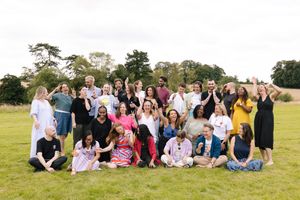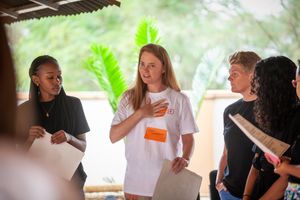Decentralised community building in Web3 — “Is it all nonsense” or could this change the world?
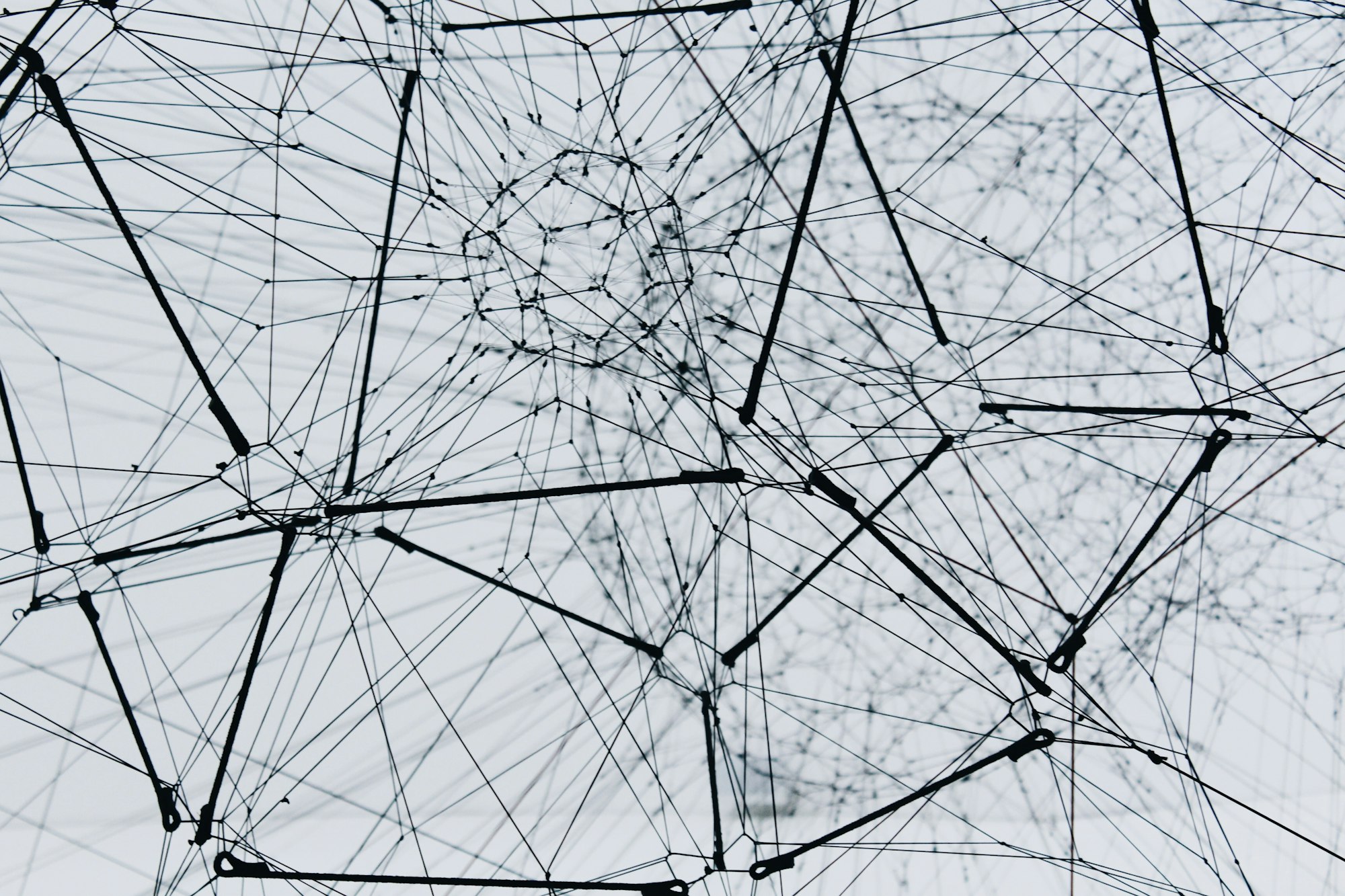
Insights from our second Collective Conversation exploring the Future of Collectives for good
Consumption warning! I’ve tried to write about this topic in an accessible way, but to avoid too many asides, or a rubbish explanation, I have purposefully not explained some terms that I recommend you are familiar with before continuing. Here is a handy Introduction to Web3, an introduction to DAOs (Decentralised Autonomous Organisations), a Web3 glossary and a Web3 beginners reading list to dip into if you need to before we begin.
On the 19th June, the Collective Conversations community gathered for a second time. For me it was a wet morning, for others a cool evening; despite our different settings, we were all gathered to talk about a hot topic: web3 and the future of community. Does web3 have the potential to change how we organise and connect with one another to solve gnarly social issues, or to our colleague Jim’s provocation — “is it all nonsense?” Alongside Jim, others brought much curiosity and some trepidation to the subject judging by the questions we received ahead of the session:
- “What is the most exciting and most terrifying thing happening to communities due to Web3?”
- “How might DAOs support us to tackle our biggest social and environmental challenges? And what are the frameworks and governance we need to ensure DAOs / web 3.0 can work to build community — not just profits for a few?”
- “How can I little by little get involved with Web3, as someone who struggles to understand it?”
We were supported to explore this issue by three Web3 experts and practitioners, who shaped a discussion about the philosophical and practical considerations of Web3 and in particular DAOs (Decentralised Autonomous Organisations). Severin Matusk founder of Co-matter is a community builder and web enthusiast, who joined us to share his thoughts on how communities in web3 could change personal identity, group behaviour and modern culture in significant and exciting ways. Alexandra McCarroll and Sarah Hamburg from Web3 consultancy Phas3 got into several inspiring case studies showing the potential of DAOs to tackle the big issues like climate change, and revolutionise industries like finance and even academia.
An hour and fifteen minutes later we departed virtual company having been enthused and energised with provocative thoughts, here is what we found.
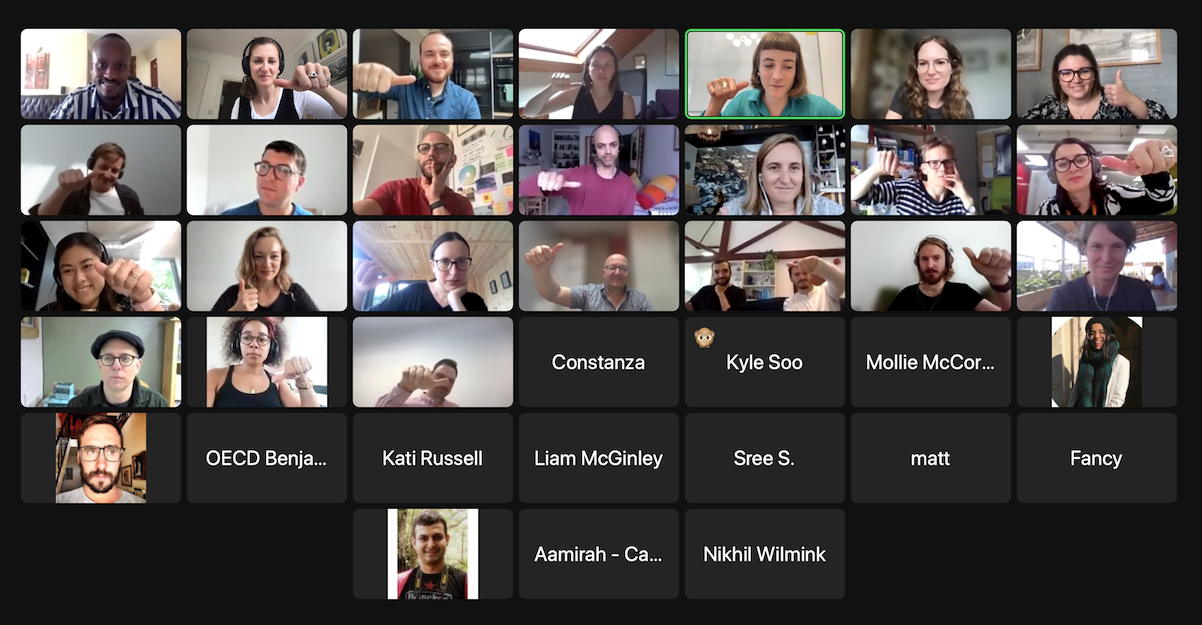
“Once upon a time people were born into communities and had to find individuality. Today, people are born individuals and have to find the communities”
This idea, a re-quote of the Artists group and shared by Severin sparked something in the audience — “I think we are all born into communities — but capitalism very quickly pushes us into an individual story. Jon Alexander describes this as the ‘consumer story’ in his book Citizens’’ said Mary. “+1111 Mary!” agreed Sara.
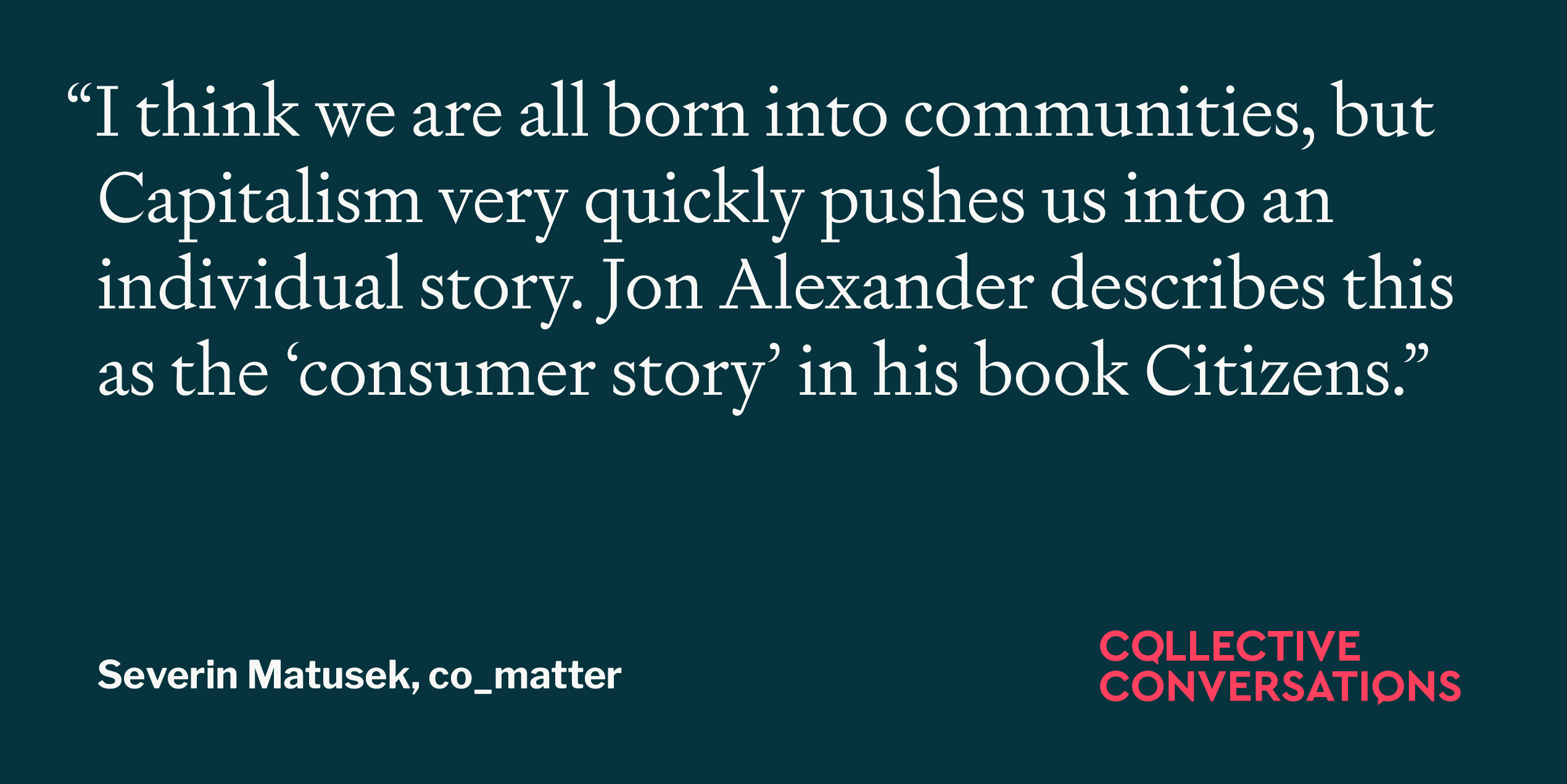
Most of us have experienced huge changes in our lifetime due to the development of the internet from how we earn money, how we communicate to how we see ourselves as humans and communities. Severin is predicting further changes in our culture in web3. He said “culture is going to change…crucial elements of communities and how we organise ourselves like governance, status, authenticity, self expression, access, equity, all of these very basic human notions of how we exist as a society and as communities are changing because of this different technology underground.”
At the same time, in Severins view, there are elements of community building that haven’t really changed what we do, just how we do it. “Community on the internet has evolved a lot. But essentially, it’s the same; the internet as a technology allows us to not only find people according to where we live, but all around the world, which is quite an amazing thing.”
Severin went on to explain a swing in the nature of our anonymity over the course of the web. In Web1 facilitated by pseudonyms in chat forums, we separated our physical identity from our real or physical selves. Web2 and the age of Facebook forced us to put in our real names thus making our virtual and physical selves much more aligned. Now as we enter Web3, separate identities, avatars, face-warping filters, and fantasy names are becoming the norm again, delivering a new kind of anonymity and sense of identity as we frequent multiple closed communities in different corners of the internet.
Instead of platforms being designed to collect data, they’re designed for privacy
Looking into how Web 1, Web2, Web3 have provided different experiences for its members (see diagram below), how does this new way of finding community impact our collective ability to collaborate, to positively progress, and protect our planet?
The audience began to mull in the zoom chat as the broader conversation continued…
- “I wonder how the return to almost-anonymity affects how we relate to each other (and accountability to not be a dick online lol)”
- “It’s interesting though with web3 you can be “anon” but still have digital reputation that you own”
- “Pseudonymous not anonymous.”

For users, the biggest appeal for participation and community building in Web3 is its ability to decentralise power and ownership. As Severin explained — “When it comes to ownership we can see, instead of extractive platform ownership, where platforms were closed off databases, we’re now going through a phase of inclusive cooperative ownership. Instead of platforms being designed to collect data, they’re designed for privacy.”
This means decentralised decision making is embedded into the blockchain technology that hosts Web3 and it takes out the need for an intermediary to transfer value from person to person. It’s a bit like buying a house directly from someone without the need for an estate agent but the protection that they provide is still guaranteed. Some call this a ‘trustless’ system meaning that there is no need for us to rely on trust because that is built into the technology. The result of this when it comes to community organising is a new kind of entity — a decentralised Autonomous Organisation — a DAO. My colleague Abi with partners at Nesta articulated these well in their writing on the topic — “DAOs are, in essence, attempting to marry decentralised protocols with human collective intelligence — automating as much as possible, while developing ways to ensure that people interact reliably with the system.”
This is exciting but worth noting that beyond gaming, often DAOs are representing real world exchange therefore humans are still responsible for ensuring the digital decision making translates into reality, that a real pizza linked to the pizza DOA is delivered to and eaten by that community member to whom it is owed.
Alex McCarroll and Sarah Hamburg from Phas3 have been participating in, running and researching use cases for DAOs for a while and are pioneering use cases that facilitate system changes for the better. The DeSci (Decentralised Science) movement is one such example. Its goal is to make scientific knowledge, and its creation, a more equitable public good.
As Sarah explained, scientific knowledge, as most of us understand it today, is one of the most important routes to greater human understanding and more importantly, social progress, but it often exists in small pockets of our society, “locked away behind paywalls…siloed in institutional databases…De-Sci aims to enhance scientific funding to enlist knowledge from all these silos, to eliminate reliance on intermediaries like publisher, publisher conglomerates, and to also increase collaboration across science.”

DeSci has grown from a collection of loosely connected DAOs emerging in 2013 to “a very coherent and connected movement to reimagine all aspects of science”. This really exemplifies the power of individuals and small communities to effect really meaningful change when they find like-minded others and become bigger than the sum of their parts. Some of the benefits Sarah sees in the DeSci movement are:
- removing the need for journals to act as a trusted intermediary for peer review and for knowledge curation
- removing the need for centralised funding bodies to make the decisions about research funding allocation
- enabling scientists to own and control the work that they produce.
- returning profits from scientific research to anybody else who was involved in research, so not just scientists, so this could include patients who took part in the research or citizens who provided funding
Web3 is such a powerful enabler of this because through the tracking of intellectual property and data through the blockchain itself these goals can be achieved and this will help create more self-sustaining scientific ecosystems. The best example of this is a successful DAO called VitaDow, who are funding longevity research through NFTs that represent scientific intellectual property. This IP and any resulting profits are owned by the DAO rather than dispersed amongst the many actors currently involved in the process of carrying out and publishing academic research.
The implication of this idea is far reaching, we’re talking about dismantling and rebuilding a sector. Another more early stage but even more revolutionary idea shared with us was how we might support decarbonisation through tokenising carbon credits in order to use carbon as a collateral asset.
“…currently, we have very poor ways to measure the value of our natural world. So when carbon is emitted into our atmosphere by a corporation, there’s no monetary loss, however, there’s a cost to our planet. By turning carbon into a collateral asset, we can place value on these emissions and then create a market for them. It’s important to note though, that there will be no market for this without the introduction of carbon taxes by governments around the world.” explained Sarah.
Perhaps web3 has enabled people to collectively dream about and test ideas that we never thought possible. Severin mentioned the role of video games in the metaverse that are enabling people to design new societies and ecosystems in a way that has real world implications.“You basically enter a community and you make your way like in a video game, you create your character, you can earn and buy currency that’s only viable within that ecosystem…you kind of co-create the world you inhabit.”
However, as our audience was keen to uncover, who is creating these new worlds? Will this progress run away with and benefit a few, leaving many left behind?
“What is the big problem that Web3 solves, and for whom? Does it just extend ownership from a tiny number of billionaires to a slightly bigger elite?”
This question from Mary in the zoom chat provoked a flurry of agreement and concerns. The group were concerned that high technical barriers to entry exclude many from getting involved in the development of Web3. Concepts like non-fungible tokens, blockchain and DAOs, are notoriously hard to get your head around.
Sarah highlighted a few more watch areas that we hadn’t thought about — “So many DAO contributors give time and invest their money in return for tokens and NFT’s in expectation of future rewards or future gains, which begs the question — are communities being treated as a commodity, like pyramid schemes treat their communities as a commodity? What governance and incentive structures can help prevent this?”. The story of the One Coin comes to mind here. This cryptocurrency saw huge success when millions were invested in it in 2015 but it was revealed to be a pyramid scheme 2 years later, having scammed all of its investors.
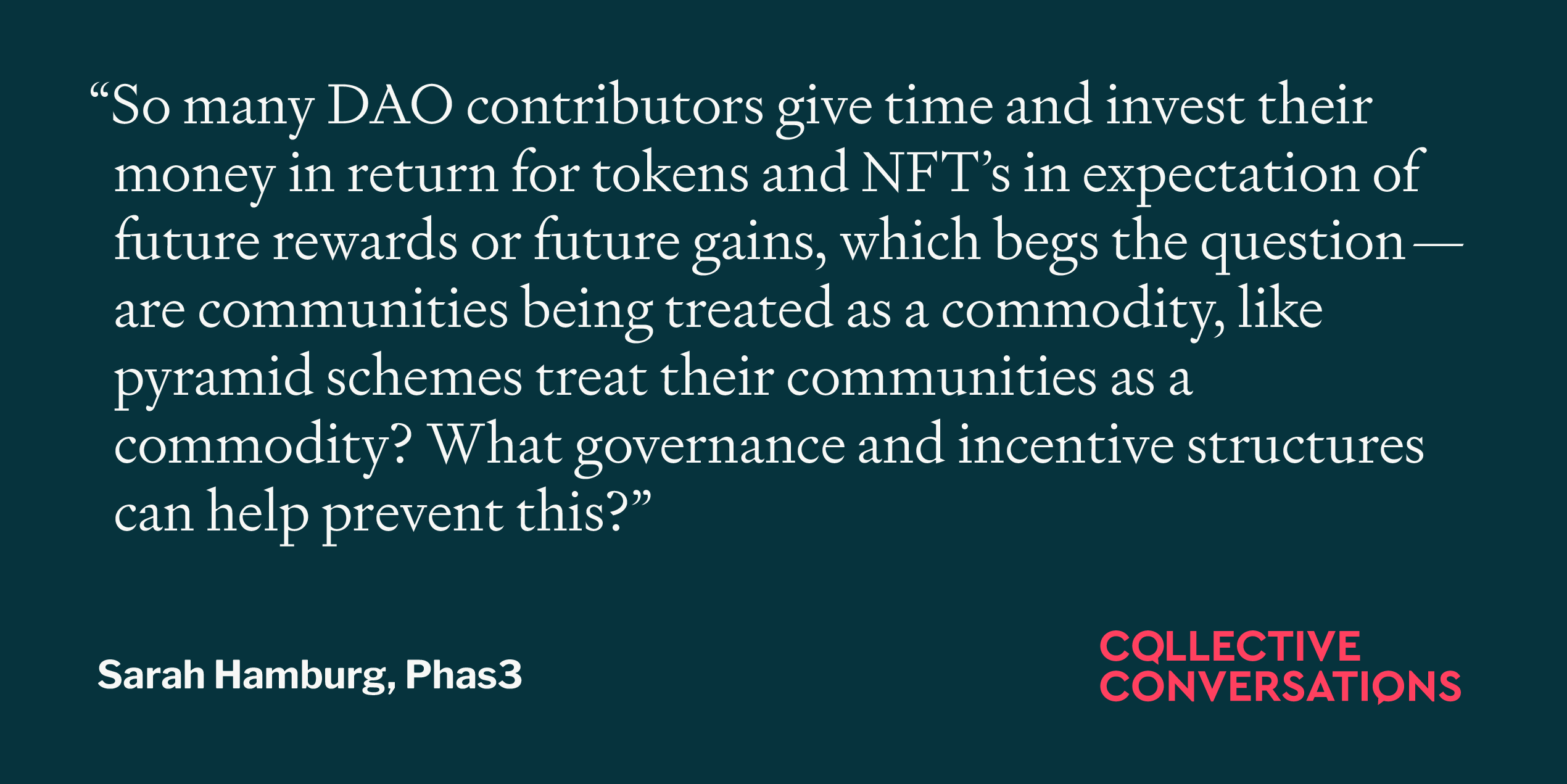
However it is also worth noting that some of the risks talked about already exist but could be amplified in Web3, such as echo chambers. We are no strangers to examples of communities that foster negative ideologies or ideas because diverse opinions have been locked out. The emphasis on many niche communities in Web3 facilitated by technology rather than people, makes this phenomenon more likely. Here is Sarah explaining this again — “…how can we foster cognitive flexibility, and encourage cognitive flexibility when communities and really entire ecosystems are heavily invested in particular solutions.”
Katie Beecroft, an expert in decentralised leadership and DAOs discusses this in depth in the podcast Leadermorphosis. She encourages us to draw from lessons learnt over many decades about governance structures and decision making in decentralised organisations, companies and communities to inform what we test and develop in Web3 today.
During our conversation, Alex and Sarah helped us to understand the most promising cases demonstrating how DAOs and Web3 can be a force not just for good but far reaching systemic change for the biggest problems of our time and most marginalised of our communities.
For many in the world having a bank account is essential for buying a house, sending money or accessing public services. In Cambodia, a country classified as Least Developed by the UN only 22% of the population has a bank account however nearly 100% of the population have a smartphone. Similarly “in 2020 88% of Mexican households had a smartphone, less than 50% had a bank account.” And this is where it becomes interesting; As Alex explained, the rise of cryptocurrencies facilitated by Web3 has provided us with an opportunity to rethink how financial institutions and currencies may look and operate going forward to include those who don’t have a bank account but do have a smartphone. CBDCs (Central Bank Digital Currency) are banks that do just this and Cambodia’s CBDC has now reached over half the population. For migrant workers this also means the ability to send money overseas to their families quicker and without large fees.
“The volume of remittances is believed to be triple that of official development aid. But currently, the majority of these transfers have large fees, so the average fee is around 7%. However, the UN has a set target for these fees to be less than 3% by 2030. Additionally, it is often difficult to access banking systems for those who are receiving these payments. Cryptocurrency payments offer an alternative, and there’s a growing number of migrant workers using cryptocurrencies to send money home. This is driven by lower fees, Faster Payments, and greater access to mobile phones over traditional bank accounts.”
However it is also important to note that CBDCs could enable authoritarian governments to monitor citizens spending, impose new currency rules and sanctions instantaneously and block any individual or company or country from using their currency.
So how and where does this land us?
As with most technological advancements, it is rarely the technology that is inherently good or bad, it’s who does what with it. Matt in the audience explained this really well; we needed to think about what he referred to as the warm vs cold components in technology. No matter what is developed and how disconnected it may look and feel from humans, there are still humans behind it choosing and then coding in biases, responses, experiences and decisions.
We can also be certain that progress of some kind within the internet will and is happening regardless. Our chat at the end of the conversation touched on this, with many urging that it was essential that we really learn from the successful and unsuccessful lessons learnt in the development of web2 — it arguably had a fair amount of success in democratising access to resources but was also developed by a relatively narrow subsection of people based mainly in Silicon Valley. It missed out from the insight of many others whose lives would soon be changed completely by it and in some cases impacted negatively by it.
I think it’s fair to say that the jury still out, but there is a sense of energy and conviction that it is no good staying on the sidelines anymore; it’s time for anyone interested in social change and the power of community to get involved in Web3 and its development to ensure it becomes the force for good that it has the potential to be.
Our two speakers and audiences at this Collective Conversations are perfect role models for this. As practitioners and or curious critics, they are taking part professionally and personally in the development of Web3, thinking carefully about whose voices are being heard and included and how. I hope you too will join them, here are some resources from them and our audience to get you started:
- A super easy introduction to ‘what is web3 and how do I learn more’ created especially for us by Alex and Sarah from Phas3
- An article on trust from the DAO Kernal
- An article on how the web3.0 could change the future of finance
- Severin’s thoughts in full in his Co-Matter newsletter. I particularly like this one about the future of community called Life is a game
- Sarah and Alex’s talk about Decentralized Science and Biotech Charta at the DeSci.Berlin Conference
- This twitter thread list and excel sheet of DAO community building grant opportunities contributed by Sarah during the Conversation
And if you read this as a newbie to Collective Conversations, read more and sign up to get updates and invites to future conversations or drop me a line at [email protected]
